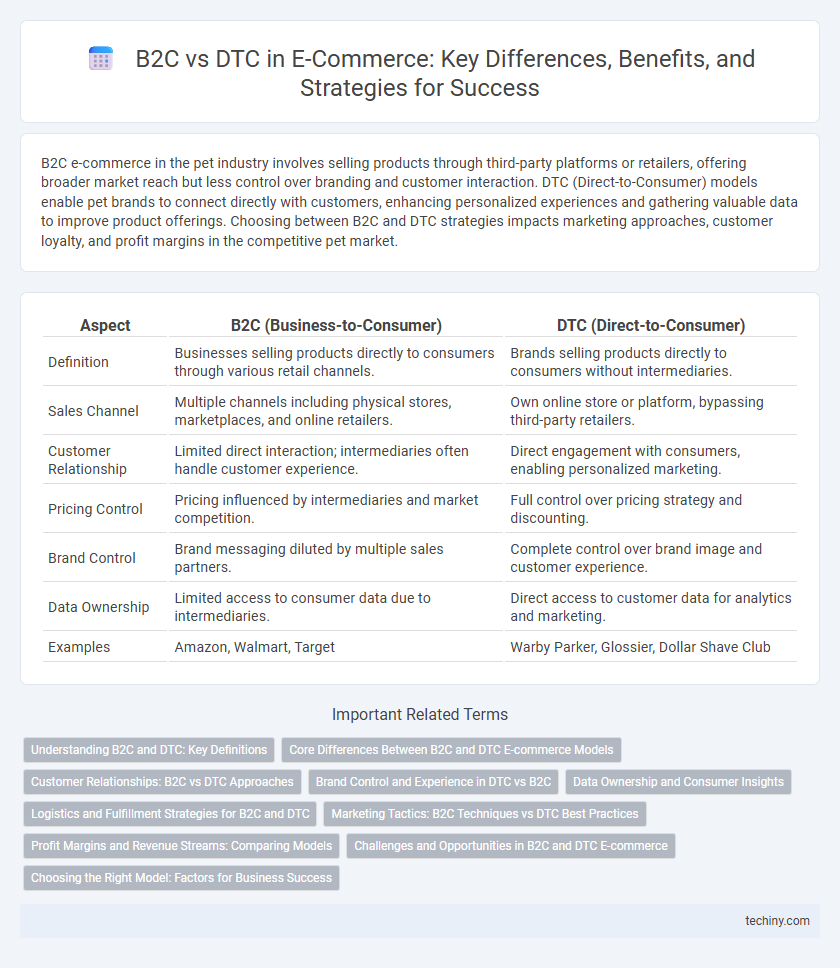B2C e-commerce in the pet industry involves selling products through third-party platforms or retailers, offering broader market reach but less control over branding and customer interaction. DTC (Direct-to-Consumer) models enable pet brands to connect directly with customers, enhancing personalized experiences and gathering valuable data to improve product offerings. Choosing between B2C and DTC strategies impacts marketing approaches, customer loyalty, and profit margins in the competitive pet market.
Table of Comparison
| Aspect | B2C (Business-to-Consumer) | DTC (Direct-to-Consumer) |
|---|---|---|
| Definition | Businesses selling products directly to consumers through various retail channels. | Brands selling products directly to consumers without intermediaries. |
| Sales Channel | Multiple channels including physical stores, marketplaces, and online retailers. | Own online store or platform, bypassing third-party retailers. |
| Customer Relationship | Limited direct interaction; intermediaries often handle customer experience. | Direct engagement with consumers, enabling personalized marketing. |
| Pricing Control | Pricing influenced by intermediaries and market competition. | Full control over pricing strategy and discounting. |
| Brand Control | Brand messaging diluted by multiple sales partners. | Complete control over brand image and customer experience. |
| Data Ownership | Limited access to consumer data due to intermediaries. | Direct access to customer data for analytics and marketing. |
| Examples | Amazon, Walmart, Target | Warby Parker, Glossier, Dollar Shave Club |
Understanding B2C and DTC: Key Definitions
B2C (Business-to-Consumer) refers to transactions where businesses sell products directly to individual customers through online platforms, marketplaces, or physical stores, emphasizing broad market reach and customer acquisition. DTC (Direct-to-Consumer) narrows this approach by eliminating intermediaries, allowing brands to sell exclusively through their own digital channels, fostering deeper customer relationships and enhanced brand control. Understanding these distinctions is crucial for optimizing marketing strategies, customer data utilization, and supply chain management in e-commerce.
Core Differences Between B2C and DTC E-commerce Models
B2C e-commerce involves third-party retailers selling products to consumers, often through large marketplaces or multiple channels, whereas DTC (Direct-to-Consumer) e-commerce sells products directly from the brand to the customer, eliminating intermediaries. B2C models prioritize broad reach and convenience through established distributors, while DTC models emphasize brand control, personalized customer experiences, and higher profit margins. The core difference lies in the supply chain; DTC streamlines product delivery and enhances data collection for targeted marketing, unlike the multi-layered structure in B2C.
Customer Relationships: B2C vs DTC Approaches
B2C ecommerce typically relies on third-party platforms and intermediaries to reach customers, which can limit direct interaction and personalized customer service. DTC brands engage customers directly through their own websites and social channels, enabling stronger relationships fostered by personalized experiences and easier feedback loops. This direct approach helps DTC businesses build long-term loyalty and gather valuable consumer data to refine products and marketing strategies.
Brand Control and Experience in DTC vs B2C
DTC (Direct-to-Consumer) brands maintain full control over their branding, customer experience, and data, enabling personalized marketing and seamless customer journeys. In contrast, B2C (Business-to-Consumer) models often rely on third-party retailers, which can dilute brand messaging and limit direct customer interactions. This control in DTC fosters stronger brand loyalty and consistent product experience, setting it apart from traditional B2C channels.
Data Ownership and Consumer Insights
B2C models often rely on third-party platforms, limiting direct access to consumer data, which restricts comprehensive ownership and detailed insights. DTC businesses collect and control first-party data, enabling precise analysis of customer behaviors and preferences for tailored marketing strategies. Enhanced data ownership in DTC empowers brands to optimize customer experience and improve lifetime value through personalized engagement.
Logistics and Fulfillment Strategies for B2C and DTC
B2C logistics typically rely on third-party carriers and larger distribution centers to handle high order volumes efficiently, while DTC brands often leverage direct shipping models and localized fulfillment hubs to enhance delivery speed and customer experience. B2C fulfillment strategies prioritize inventory centralization and cost-effective mass shipping, whereas DTC emphasizes agility with customized packaging and real-time inventory management tailored to individual consumer demands. Optimizing last-mile delivery and return processes differentiates DTC logistics, fostering stronger brand-consumer relationships compared to traditional B2C approaches.
Marketing Tactics: B2C Techniques vs DTC Best Practices
B2C marketing tactics often emphasize broad reach through multi-channel advertising, leveraging social media, search engine marketing, and retail partnerships to drive traffic and sales. In contrast, DTC best practices prioritize personalized customer experiences, data-driven targeting, and direct engagement via owned channels like brand websites and email marketing, fostering stronger brand loyalty and higher lifetime customer value. Employing retargeting campaigns and influencer collaborations is effective in both models but optimized differently to suit either mass-market or niche, direct consumer segments.
Profit Margins and Revenue Streams: Comparing Models
B2C (Business-to-Consumer) models typically involve intermediaries such as wholesalers and retailers, which can reduce overall profit margins due to shared revenue streams. DTC (Direct-to-Consumer) models eliminate middlemen, allowing brands to retain higher profit margins by controlling pricing, marketing, and customer data directly. Revenue streams in DTC are more diversified and scalable through personalized marketing, subscription services, and direct customer engagement, enhancing overall profitability.
Challenges and Opportunities in B2C and DTC E-commerce
B2C e-commerce faces challenges such as high customer acquisition costs and reliance on third-party platforms that reduce profit margins, yet it offers opportunities to tap into large, established customer bases and leverage brand visibility. DTC e-commerce presents opportunities for enhanced customer data collection and personalized marketing but struggles with building trust and scaling logistics independently. Both models demand robust digital strategies to navigate competitive markets while maximizing customer engagement and retention.
Choosing the Right Model: Factors for Business Success
Choosing the right model between B2C and DTC depends on factors such as brand control, customer engagement, and cost efficiency. B2C leverages established retail channels to reach a broad audience quickly, while DTC provides direct customer relationships and greater data insights for personalized marketing. Evaluating supply chain capabilities and profit margins helps businesses align their model with long-term growth objectives in the competitive e-commerce landscape.
B2C vs DTC Infographic

 techiny.com
techiny.com